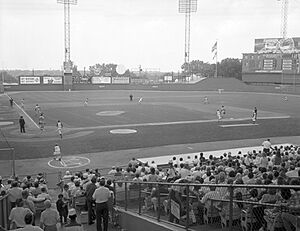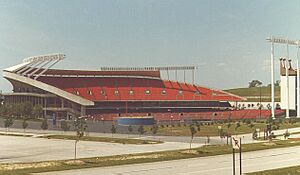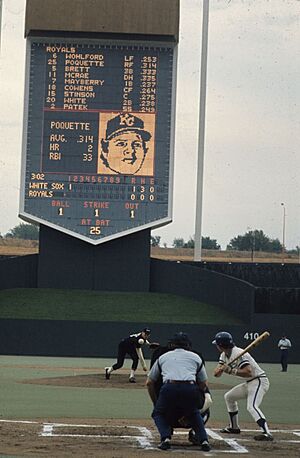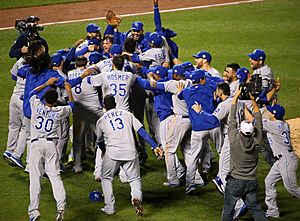History of the Kansas City Royals facts for kids
The history of the Kansas City Royals is all about a Major League Baseball team that started playing in 1969. They play in Kansas City, Missouri. The team is part of the American League Central Division. Over the years, the Royals have won one wild card spot, seven division titles, four league championships, and two World Series titles!
Contents
- Baseball Comes Back to Kansas City
- 1969–1979: The Royals Take Off
- 1980–1984: From Pennant to Pine Tar
- 1985: The "I-70 Series"
- 1986–1994: Staying Strong
- 1995–2002: A Tough Time for the Royals
- 2003: A Winning Season!==
- 2004–2012: Hitting Rock Bottom
- 2013–2014: Back in the Game
- 2015: Second World Series Championship
- 2016–Present: After the Championship
- See also
Baseball Comes Back to Kansas City
After the Kansas City Athletics baseball team moved to Oakland in 1967, Kansas City was left without a major league team. This was the first time since 1883 that the city didn't have professional baseball.
A U.S. Senator named Stuart Symington was very upset. He threatened to change laws so that baseball would have to give Kansas City a new team. Major League Baseball agreed to add new teams quickly in 1967. Kansas City was promised a team to start in 1971.
But Senator Symington wanted a team sooner. He pushed MLB to let the new teams start playing in 1969. This helped Kansas City get its team faster.
A businessman named Ewing Kauffman won the chance to own the new Kansas City team. He held a contest to find the best name for the team. Sanford Porte suggested "Royals." This name honored Missouri's big livestock industry and the American Royal show in Kansas City. The name was chosen from 17,000 ideas. The team's logo, a crown on a shield with "KC," was designed by Shannon Manning from Hallmark Cards.
1969–1979: The Royals Take Off
The Royals started with General Manager Cedric Tallis. He became known for making great trades. One of his first big trades brought in Lou Piniella, who became the MLB Rookie of the Year in 1969.
On April 8, 1969, the Royals played their first game. They beat the Minnesota Twins 4-3 in 12 innings. Pitchers Wally Bunker and Moe Drabowsky helped them win.
After their first season, the Royals made more smart trades. They got speedy outfielder Amos Otis, who became the team's first big star. Other important players like Cookie Rojas, Fred Patek, John Mayberry, and Hal McRae joined the team. The Royals also built a strong system to develop young players. This brought future stars like pitchers Paul Splittorff and Steve Busby, and infielders George Brett and Frank White.
In 1971, the Royals had their first winning season. Manager Bob Lemon led them to second place. In 1973, the Royals started wearing their famous "powder blue" road uniforms. They also moved from Municipal Stadium to the new Royals Stadium. This stadium had deep outfield walls and artificial turf. It was perfect for a team that loved aggressive base running and good defense. The stadium was built next to Arrowhead Stadium, home of the Kansas City Chiefs football team.
Manager Whitey Herzog took over in 1975. The Royals then started to become one of the best teams in the American League West. In 1975, they finished second with a 91-71 record.
The 1976 season was a big year for the Royals. First, George Brett won the batting title on the last day of the season. Second, the Royals won the first of three straight Western Division championships. They played against the New York Yankees in the American League Championship Series three times in a row. Even though the Royals won more regular season games in two of those years, they lost to the Yankees each time. In two of those years, they lost in the ninth inning of the final game.
These playoff games helped George Brett become a superstar. He hit three home runs in the final game of the 1978 playoffs. Besides Brett, other key players were Frank White, Hal McRae, Al Cowens, pitchers Dennis Leonard and Larry Gura, and closer Dan Quisenberry.
1980–1984: From Pennant to Pine Tar
After finishing second in 1979, manager Whitey Herzog was fired. Jim Frey became the new manager. In 1980, the Royals bounced back. They reached the ALCS and faced the Yankees again. The team was led by Brett, who almost hit .400 and won the AL MVP. Willie Wilson also thrilled fans with his stolen bases and inside-the-park home runs.
In the 1980 ALCS, the Royals finally beat the Yankees. They swept them in three games! George Brett hit a famous home run off Yankees' star pitcher Goose Gossage. Frank White was named the playoffs MVP for his great play.
However, in their first World Series, the Royals lost to the Philadelphia Phillies in six games. The Phillies had future Hall of Famers like Mike Schmidt and Steve Carlton. Willie Aikens made history by hitting two home runs in two different World Series games.
The Royals returned to the playoffs in 1981. They lost to the Oakland Athletics in a special series caused by a baseball strike.
In 1983, the Royals had a strange moment. In a game against the Yankees, George Brett hit a home run in the ninth inning. But the Yankees manager said Brett had too much pine tar on his bat. After checking, the umpires called Brett out, and the game ended. Brett famously stormed out of the dugout to argue!
Also in 1983, John Schuerholz became the new general manager. He helped build up the team's young talent. This included pitchers like Bud Black, Danny Jackson, Mark Gubicza, David Cone, and Bret Saberhagen.
Under manager Dick Howser, the Royals won their fifth division championship in 1984. They relied on Brett's hitting and the young pitching of Saberhagen, Gubicza, and others. But they were swept by the Detroit Tigers in the ALCS.
1985: The "I-70 Series"
In 1985, the Royals won their division for the sixth time in ten years. Bret Saberhagen won the Cy Young Award for his amazing pitching. George Brett had an incredible hitting streak at the end of the season. This helped the Royals catch up and pass the California Angels.
In the ALCS against the Toronto Blue Jays, the Royals were down 2-0. But George Brett had an amazing Game 3, hitting two home runs and a double. The Royals fell behind 3-1 in the series. But they made an incredible comeback, winning 4-3! This was the first year the ALCS was a best-of-seven series, which allowed the Royals to win. Brett was named ALCS MVP.
1985 World Series Victory
In the 1985 World Series, the Royals played against the St. Louis Cardinals. This was called the "I-70 Series" because both teams are in Missouri and connected by Interstate 70. The Royals again fell behind 3-1.
The key game was Game Six. The Royals were losing 1-0 in the bottom of the ninth inning. But they rallied to score two runs and win! A controversial call at first base helped the rally. Outfielder Jorge Orta was called safe, even though it looked like he was out.
After that call, the Cardinals seemed to lose focus. The Royals then won with a hit by pinch hitter Dane Iorg. In Game Seven, the Cardinals struggled, and the Royals won 11-0. This gave the franchise its first World Series title!
1986–1994: Staying Strong
In 1986, the Royals didn't do as well, finishing in third place. They also made a bad trade, sending future All-Star David Cone away. The Royals were expected to win in 1987, but they finished second in their division. Sadly, on June 17, 1987, manager Dick Howser passed away after fighting brain cancer. His number 10 was the first number the Royals ever retired.
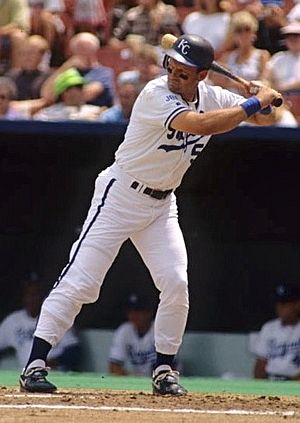
In the late 1980s and early 1990s, the Royals developed young stars like Bo Jackson and Tom Gordon. They often had winning records but couldn't reach the playoffs. For example, in 1989, the Royals won 92 games. This was the third-best record in baseball, but they still didn't make the playoffs. They finished second behind the Oakland Athletics.
Many highlights from this time focused on the end of George Brett's career. He won his third and final batting title in 1990. This made him the first player to win batting titles in three different decades! He also got his 3,000th hit. Brett retired after the 1993 season.
The strike-shortened 1994 season was the last time the Royals were close to greatness for a long time. Led by manager Hal McRae and Cy Young Award-winner David Cone, the Royals had a 14-game winning streak before the season ended early due to a players' strike.
1995–2002: A Tough Time for the Royals
The 1990s were hard for the Royals. General Manager John Schuerholz left in 1990. Then, team owner Ewing Kauffman passed away in 1993. Kauffman's death left the team without a permanent owner. Wal-Mart CEO David Glass, a friend of Kauffman, became the temporary CEO.
Glass eventually bought the team himself for $96 million in 2000. He was the only person interested in buying the team and keeping it in Kansas City.
After the 1994 season, the Royals decided to spend less money. They traded away star players like pitcher David Cone and outfielder Brian McRae. The team's payroll, which used to be one of the highest, dropped a lot. By 1996, it was one of the lowest in baseball.
In 1997, the Royals had a chance to switch to the National League. This would have meant playing teams like the St. Louis Cardinals and Chicago Cubs more often. But the team's board of directors decided not to make the move. The Milwaukee Brewers switched leagues instead.
As the 1990s ended, fewer people came to Royals games. Player salaries kept going up, and the Royals found it hard to keep their best players. They traded players like Kevin Appier, Johnny Damon, and Jermaine Dye for younger players. But most of these younger players didn't turn out to be very good. This led to a long period of losing for the team.
In 1999, the Royals had their worst record ever, losing 97 games. They lost 97 games again in 2001. The only bright spots were the fast development of Carlos Beltrán (Rookie of the Year in 1999) and Mike Sweeney.
In 2002, the Royals lost 100 games for the first time in their history. The team also tried out new black and dark blue jerseys, but fans had mixed feelings. By 2006, the Royals went back to their classic uniform style.
2003: A Winning Season!==
The 2003 season brought a short break from the losing. Manager Tony Peña, in his first full season, led the team to its first winning record (83-79) since 1994. They finished third in their division. Peña was named the American League Manager of the Year. Shortstop Ángel Berroa was named AL Rookie of the Year.
2004–2012: Hitting Rock Bottom
From 2004 to 2012, the Royals had nine losing seasons in a row. This was the longest losing streak in team history. In six of those years, they finished last in their division. In eight of those nine seasons, they lost at least 90 games. The worst years were 2004-2006, when they lost at least 100 games each year. In 2005, they set a team record by losing 106 games.
In 2004, the Royals traded away star players like Carlos Beltrán for younger players. But these new players didn't help the team much right away. The team continued to struggle.
In 2005, the Royals had one of the lowest payrolls in baseball. Many of their players were young. Manager Tony Peña resigned in May. The Royals then had a terrible 19-game losing streak. They ended the 2005 season with a 56-106 record. This was the third time in four seasons that they set a new record for the worst team record.
To try and turn things around, General Manager Allard Baird signed several experienced players before the 2006 season. But these new players didn't lead to many more wins. The Royals had another 100-loss season in 2006. They became one of only 11 teams in baseball history to lose 100 games in three straight seasons. Baird was fired in May, and Dayton Moore became the new GM. Moore's first goal was to create a new team motto: "True. Blue. Tradition."
Many people believed the team's owner, David Glass, didn't spend enough money on players. For the first six years he owned the team, the Royals' payroll was almost always among the lowest in baseball.
In 2007, the Royals started spending a bit more money. They signed pitcher Gil Meche to a big contract. They also added new young players like Alex Gordon and Billy Butler. In June and July 2007, the Royals had their first winning months since 2003. They finished the season with 69 wins, avoiding 100 losses. But they still finished last in their division.
In the 2007 MLB draft, the Royals picked shortstop Mike Moustakas as the second overall pick.
For the 2008 season, the Royals hired Trey Hillman as their new manager. As part of their "New. Blue. Tradition." motto, the Royals brought back their classic powder blue uniforms for weekend home games. They had worn these uniforms from 1973 to 1991.
The Royals started the 2008 season well, sweeping the Detroit Tigers. They were 8-5 and in first place after 13 games. But they faded later in the season. They finished in fourth place with a 75-87 record. This was the first time in five years they didn't finish last or lose 93 or more games.
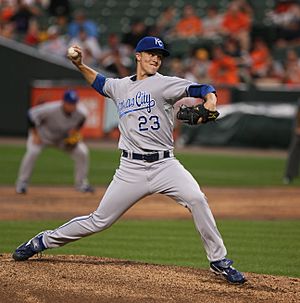
Before the 2009 season, Kauffman Stadium was renovated. The Royals started April at the top of their division, which made fans excited. But the team struggled as the season went on. They finished last with a 65-97 record.
The highlight of 2009 was pitcher Zack Greinke. He didn't allow any earned runs in his first 24 innings! He finished the year with the best earned run average in baseball and won the American League Cy Young Award. Greinke was only the third Royals player to win this award.
In 2010, the Royals had a tough start. Manager Trey Hillman was fired, and Ned Yost took over. The team finished last again with a 67-95 record.
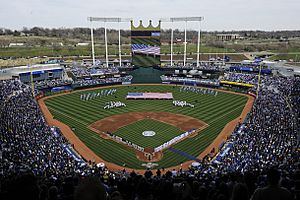
The Royals started the 2011 season strong, with a 10-4 record. But their success didn't last. By the All-Star break, they had the worst record in the American League. However, young players like Eric Hosmer and Aaron Crow emerged. Alex Gordon also had a great year in left field, winning a Gold Glove for his defense. The team finished in fourth place.
2013–2014: Back in the Game
On December 10, 2012, the Royals made a big trade. They got pitchers James Shields and Wade Davis from the Rays. This trade helped the team start winning again.
The 2013 season began very well. The Royals had their first winning season since 2003, finishing 86-76. This was their best winning percentage since 1994.
The 2014 season was even better! The Royals made it to the playoffs for the first time in 29 years. In July, they had a losing record. But they went on an amazing run, winning 22 out of 27 games. This pushed them into first place in their division in August. They finished the regular season one game behind Detroit. But they earned the franchise's first ever wild card spot and a playoff appearance!
The Royals made the most of their 2014 playoff run. They won a record 8-0 in the first three rounds! They beat the Oakland Athletics in the Wild Card Game. Then they swept both the Los Angeles Angels of Anaheim and the Baltimore Orioles. However, the Royals lost the World Series to the San Francisco Giants in seven games.
2015: Second World Series Championship
After their great playoff run, the 2015 Royals were energized. They won the American League Central division, their first division title since 1985. In the ALDS against the Houston Astros, the Royals were down 2-1 in the series. They were also losing by four runs in Game 4. But Kansas City scored seven runs in the last two innings to win! They then won the deciding game to advance. In a rematch of the 1985 ALCS, the Royals beat the Toronto Blue Jays in six games. This sent them to their second straight World Series!
2015 World Series Victory
In the 2015 World Series against the New York Mets, the Royals showed they were great under pressure. In Game 1, Alex Gordon hit a home run in the ninth inning to tie the game. Then Eric Hosmer hit a game-winning sacrifice fly in the 14th inning.
In Game 4, the Mets were close to tying the series. But the Royals scored three runs in the eighth inning to win. This put them one game away from the championship. In Game 5, the Mets were three outs away from forcing Game 6. But the Royals scored two runs to tie the game. Then Christian Colón hit the winning run in the 12th inning. Kansas City won 7-2 and clinched their second World Series championship! All-Star catcher Salvador Pérez was named Series MVP for his clutch hitting and great pitch calling.
2016–Present: After the Championship
After winning the World Series, the Royals didn't do as well. They finished third in their division in 2016 and 2017. They lost All-Stars Hosmer and Lorenzo Cain to other teams. The Royals then struggled again, losing over 100 games in both 2018 and 2019. Manager Ned Yost retired in 2019, and Mike Matheny took over.
In the short 2020 season, the Royals went 26-34. In 2021, they finished fourth in their division. Salvador Pérez had a huge year, leading the American League with 48 home runs and 121 RBIs.
In 2022, Dayton Moore was promoted, and J. J. Picollo became the new general manager. The Royals used many young players that year, including Bobby Witt Jr., MJ Melendez, and Vinnie Pasquantino. The team finished fourth again, and Matheny was fired. On October 30, 2022, the Royals hired Matt Quatraro as their new manager.
See also
- Kansas City Royals Baseball Academy
- List of Kansas City Royals seasons


